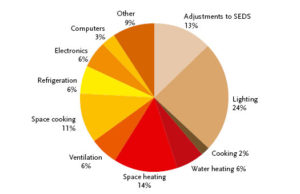 Building energy use is becoming more and more important as the cost of energy is increasing. It does not seem to matter whether it is electricity, gas, oil or whatever, they are all going up by leaps and bounds contrary to what the government says.
Building energy use is becoming more and more important as the cost of energy is increasing. It does not seem to matter whether it is electricity, gas, oil or whatever, they are all going up by leaps and bounds contrary to what the government says.
The 13% on the circle on the left represents uncertainty in the data, or in other words it could not be easily attached to any of the other categories. The chart above is pretty interesting since it depicts how we use energy on average for our homes since the industrial sector is excluded from these calculations. It also tells us were to focus our energy in terms of reduction in the use of fuels to get the most bang for our investment in money and time.
Building Energy Use – List of Energy Use by Importance
Our total annual energy cost for 2011 was $2952.00 for electricity, heating and water. We decided to include water here since it is a form of natural resource that we are slowly using up.
Using the percentages from the chart above we calculated how much energy we used from last year in terms of a dollar amount. We assumed that we are an average user. You can see these cost amounts in the 3rd column below.
Next we assumed a 10% reduction, only for the big ticket items to assess how much we might save in dollar terms. Ten percent should be pretty simple to meet as an objective. These numbers are in the last column and were only calculated for anything 6% and over assuming we could take steps to reduce energy use in these areas, including the SEDS which is the unidentified energy use.
The total savings added up to $280 in savings over a year or 9.4% over all. This actually should be quite achievable for most people.
| Category: | % | Cost $ | 10% Reduction |
| Lighting | 24 % | $708 | $71 |
| Space heating | 14 % | $413 | $41 |
| SEDS | 13 % | $383 | $38 |
| Space cooking | 11 % | $324 | $32 |
| Other | 9 % | $265 | $26 |
| Refrigeration | 6 % | $177 | $18 |
| Water Heating | 6 % | $177 | $18 |
| Electronics | 6 % | $177 | $18 |
| Ventilation | 6 % | $177 | $18 |
| Computers | 3 % | $89 | $0 |
| Cooking | 2 % | $59 | $0 |
How can We Save 10%
The answer is pretty easy. These are just a few suggestion to help you get started saving energy.
In fact you will likely save much more than just 10% if you are able to get the entire family involved in reducing your energy consumption.
Building energy use is only going to increase over time. It will help now to minimize the usage and the cost by employing some or all of these suggestions. These figures are for residential use and although important to the average home owner are far more important to any industrial building owner which we have not reviewed here at all.
We will list a few of the potential areas that can save you energy and the associated cost, as follows:
- Lights off when you leave the room
- Convert all lights to fluorescent or LED
- Turn down the thermostat by 5 degrees
- Convert to low flush toilets
- Shorter showers
- Install low flow shower heads
- Turn the temperature up on the fridge by 2 degrees
- Reduce the temperature of your water heater down by 5 degrees
- Turn off power to TV’s, computers etc i.e. unplug them
- Set furnace fan to auto rather than always on
These are just examples, which can be applied to almost any home! Get started now with identifying those areas that can reduce your energy use.
For more information about conserving energy and energy use in buildings, click here.